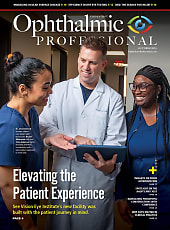Diabetic retinopathy represents the leading cause of irreversible blindness in working-aged patients, while age-related macular degeneration (AMD) is the leading cause in individuals 65 and older.1-5 Despite the differences in the overall pathogenesis of these conditions, macular edema and/or subretinal fluid are a shared cause of permanent vision loss for both diabetic macular edema (DME) and neovascular AMD (nAMD).5 Anti-VEGF injections are the main treatment modality for both of these conditions.5
Patients undergoing anti-VEGF therapy commonly require years of treatment, with many continuing indefinitely. Patients can notice a significant improvement in their visual acuity when edema and/or subretinal fluid resolve. However, damage to underlying retinal photoreceptors caused by macular edema or subretinal fluid can be irreversible, limiting a patient’s full visual potential.2,5,6 Although addressing macular edema and subretinal fluid is critical, optimizing visual outcomes includes addressing refractive error. Refractive errors are often inadequately addressed in patients undergoing anti-VEGF treatment, yet correction of these errors could play a crucial role in maximizing visual acuity in patients with DME and nAMD.7-9
Refractive Error and Its Role in Anti-VEGF Treatment Plans
Although spectacles are a highly effective option for treating refractive error, several factors influence their accuracy. These include anatomic factors like tear film abnormalities, corneal irregularities, and changes in ocular lenses; environmental factors like poor lighting; and patient factors like dryness from screen use, poor cooperation, and subjective errors during measurement.8-10
Another anatomic factor that could influence a refraction is retinal changes secondary to macular edema and subretinal fluid. Subretinal fluid can potentially displace retinal photoreceptors anteriorly, resulting in a net hyperopic shift. Macular edema’s effect on visual acuity may impact a patient’s ability to provide accurate responses during subjective refractions. These issues raise concerns that updating refractions during anti-VEGF therapies may lead to suboptimal spectacle correction because retinal changes from fluid resolution render them inaccurate over time. As a result, retinal specialists often delay updating refraction until macular edema and subretinal fluid resolve or show significant improvement.7,8
However, little research has been conducted exploring the magnitude of the refractive shift during anti-VEGF therapy and whether updating refractions should be avoided during treatment. Delaying refractive correction may be counterproductive when the overarching goal is to maximize a patient’s visual function. Robust studies exploring the impact of anti-VEGF therapy on refractive error are essential to inform evidence-based clinical guidelines and to improve patient outcomes.
Recent Studies Exploring the Effect of Anti-VEGF Treatments on Refractive Error
Recent studies have shown that refractive shifts associated with anti-VEGF treatments are generally small and that patients may warrant updated refractions despite ongoing therapy.8,9 In 2022, Salabati et al investigated refractive error changes in patients undergoing anti-VEGF treatments for DME.8 The researchers used data from the Diabetic Retinopathy Clinical Research (DRCR) Network’s Protocol T, which originally demonstrated the effectiveness of anti-VEGF medications compared to laser photocoagulation in DME management.11,12 In short, this study assessed the effectiveness of bevacizumab (Avastin, used off-label; Genentech/Roche), ranibizumab (Lucentis; Genentech), and aflibercept (Eylea; Regeneron) in patients with DME, and its data have been used in numerous publications since its availability.11 Patients were followed for 2 years and underwent protocol refraction and optical coherence tomography (OCT) imaging at each follow-up visit. Of the 660 patients enrolled in the DRCR study, Salabati et al included 543, excluding those who underwent cataract surgery (n=35) and individuals with vision worse than 20/100 (n=82).8,12 These exclusions were based on prior evidence demonstrating that protocol refractions on patients with visual acuity worse than 20/100 are less reliable and the potential influence lenticular changes could have on study outcomes.13,14 Ultimately, this represented the first large study to explore the theoretical refractive shift while treating retinal edema and subretinal fluid.
Over 2 years, patients experienced a statistically significant, albeit small, hyperopic shift in both the study eye (SE) and fellow eye (FE). The mean spherical shift of the SEs and FEs were ~0.10 D and ~0.15 D, respectively.8 Although statistically significant, these changes were unlikely to be visually significant, because refractive shifts >0.50 D are typically required to impact visual acuity in most patients.15 Salabati et al further observed a statistically significant refractive shift in pseudophakic patients with edema compared to those without edema (0.18 D).8 Phakic eyes with baseline intraretinal fluid that later resolved also experienced a statistically significant spherical change at year 1 (0.19 D) and year 2 (0.16 D). Despite these findings, the shifts remained relatively small and therefore not likely visually significant.15
Refractive shifts >1.0 D were observed in 11.4% of SEs at year 1 and 16% at year 2, but no significant factors were identified within this group.8 Salabati et al found no other statistically significant differences comparing spherical equivalent shifts between SE and FE, FEs requiring treatment and FEs not requiring treatment, or related to lens status, baseline hemoglobin A1c, or central subfield thickness. Ultimately, Salabati et al recommended that providers consider offering updated refractions to patients with DME undergoing anti-VEGF treatment, even in the presence of persistent macular edema. Of note, most physicians currently recommend holding refraction in patients undergoing anti-VEGF treatments.7,8
Expanding on Salabati et al’s findings, Lovett et al presented preliminary data at the 2024 American Academy of Ophthalmology (AAO) meeting examining refractive error changes in patients with nAMD undergoing anti-VEGF treatment.9 Lovett et al used data from the Comparison of Age-Related Macular Degeneration Treatment Trials (CATT), which included 1,185 patients with previously untreated nAMD. The CATT study compared the effectiveness of bevacizumab and ranibizumab.16 Similar to the DRCR study, patients underwent protocol refractions and OCT imaging and were followed for 2 years.8,16 Lovett et al excluded patients with vision worse than 20/100, but were unable to match for baseline lens status due to database limitations.9,13,14
The final results from Lovett et al are pending publication, but the presentation highlighted similar findings as Salabati et al, adding that many patients with nAMD have minor changes in refractive error and can obtain updated refractions during anti-VEGF treatment.9 Of note, patients who were both phakic and had a notable reduction in their subretinal fluid and subretinal tissue complex, and patients with larger amounts of fluid at baseline, were found to experience greater myopic shifts, some of which would likely be visually significant.9
These retrospective studies demonstrated that patients undergoing anti-VEGF therapy are generally good candidates to update their spectacles to improve their visual acuity and function. Clinical factors should be considered in patients who are both phakic and have a large decrease in subretinal fluid and subretinal tissue complex or who have significant edema or subretinal fluid at baseline, because those patients are more likely to have larger changes in refractive error during anti-VEGF treatment. Ultimately, the benefits of correcting refractive error should be balanced against the risks of needing more frequent refractions during anti-VEGF therapy.8,9
Both studies relied on post hoc analyses of established databases using OCT imaging and protocol refractions. Measures such as masking and intergrader reliability ensured OCT grading validity. Protocol refractions were standardized and completed by certified technicians, but there is an inherent subjective bias that could influence results.8,9 Neither study could control for factors like corneal irregularities or tear film abnormalities, which could also influence refraction. Despite these limitations, both studies featured large sample sizes, high follow-up rates, standardized protocol refractions, and measures to ensure OCT imaging accuracy.8,9
Conclusion
Anti-VEGF therapies have become the mainstay treatment for nAMD and DME, conditions that are leading causes of irreversible vision loss both in the United States and worldwide.1-5 Current interventions focus on preserving the remaining visual potential in these patients by reducing edema and subretinal fluid to minimize further damage to retinal photoreceptors. However, refractive error is another cause of vision loss in many patients undergoing anti-VEGF treatment.
Updating spectacles during treatment can enhance a patient’s overall quality of life and daily function.8,9,17-19 Historically, providers have been hesitant to offer updated refractions during anti-VEGF treatments due to concerns related to the potential for fluctuations in the necessary refractive correction. Studies by Salabati et al and Lovett et al are among the largest to investigate refractive error changes during anti-VEGF treatment and evaluate the feasibility of offering updated refractions as edema resolves.8,9 These studies have demonstrated that refractive changes are often relatively small and likely not visually significant in most patients.7-9,15 Larger refractive shifts are observed in some patients, most notably those who are both phakic and have a large improvement in their subretinal fluid and subretinal tissue complex and those with large amounts of fluid at baseline.8,9 These patients can experience shifts >1.0 D, which would likely be visually significant.8,9,15 For these patients, holding refraction until stabilization or resolution of macular edema and/or subretinal fluid may be warranted.9 Clinically, the results of these studies may encourage providers to consider updating refractions in patients undergoing treatment with anti-VEGF agents for DME and nAMD because significant benefits may be possible. RP
|
Mean (SD) Spherical Equivalent (D) |
Patients With Phakic Study Eyes (n=519) |
Patients With Pseudophakic Study Eyes (n=652) |
||||
|
Study Eye |
Fellow Eye |
P-value |
Study Eye |
Fellow Eye |
P-value |
|
|
Baseline |
1.22 (1.89) |
0.83 (1.84) |
<0.0001 |
0.14 (1.19) |
0.05 (1.41) |
0.09 |
|
Change at 52 Weeks |
-0.08 (0.82) |
0.04 (0.79) |
0.01 |
-0.04 (0.78) |
0.13 (0.91) |
0.0003 |
|
Change at 104 Weeks |
-0.19 (0.97) |
0.04 (0.96) |
<0.0001 |
-0.06 (0.90) |
0.10 (1.00) |
0.006 |
Table 1: Changes in the spherical equivalent of study and fellow eyes over two years of treatment. The magnitude of the myopic shift was greater in phakic eyes (-0.19 ± 0.97 D) compared to pseudophakic eyes (-0.06 ± 0.90 D) (p = 0.03). Results are stratified by the baseline lens status of the study eye.
|
Multivariable Regression Analysis |
Phakic Study Eyes (N=461) |
Pseudophakic Study Eyes (N=537) |
||
|
Coefficient (SE) |
P |
Coefficient (SE) |
P |
|
|
Change of Retinal Thickness |
-0.04 (0.03) |
0.23 |
0.01 (0.03) |
0.76 |
|
Change of Subretinal Fluid Thickness |
-0.21 (0.05) |
<0.0001 |
-0.19 (0.05) |
<0.0001 |
|
Change of Subretinal Tissue Complex Thickness |
-0.12 (0.03) |
<0.0001 |
-0.12 (0.03) |
<0.0001 |
|
Change in Total Thickness |
-0.10 (0.02) |
<0.0001 |
-0.07 (0.02) |
<0.0001 |
Table 2: Relationship between refractive error changes and fluid types after 2 years of treatment. Patients with higher baseline fluid thickness exhibited a greater myopic shift over two years.
References
1. Eisma JH. Current knowledge on diabetic retinopathy from human donor tissues. World J Diabetes. 2015;6(2):312. doi:10.4239/wjd.v6.i2.312
2. Deng Y, Qiao L, Du M, et al. Age-related macular degeneration: epidemiology, genetics, pathophysiology, diagnosis, and targeted therapy. Genes Dis. 2022;9(1):62-79. doi:10.1016/j.gendis.2021.02.009
3. Steinmetz JD, Bourne RRA, Briant PS, et al. Causes of blindness and vision impairment in 2020 and trends over 30 years, and prevalence of avoidable blindness in relation to VISION 2020: the Right to Sight: an analysis for the Global Burden of Disease Study. Lancet Glob Health. 2021;9(2):e144-e160. doi:10.1016/S2214-109X(20)30489-7
4. Bourne RRA, Jonas JB, Bron AM, et al. Prevalence and causes of vision loss in high-income countries and in Eastern and Central Europe in 2015: magnitude, temporal trends and projections. Br J Ophthalmol. 2018;102(5):575-585. doi:10.1136/bjophthalmol-2017-311258
5. Chhablani J, ed. Retinal and Choroidal Vascular Diseases of the Eye. 1st ed. Academic Press; 2024.
6. Kropp M, Golubnitschaja O, Mazurakova A, et al. Diabetic retinopathy as the leading cause of blindness and early predictor of cascading complications—risks and mitigation. EPMA J. 2023;14(1):21-42. doi:10.1007/s13167-023-00314-8
7. Sim KT, Tong L, Vernon SA. Does macular laser alter the refraction in a diabetic with maculopathy? A pilot study. Eye. 2001;15(5):591-594. doi:10.1038/eye.2001.191
8. Salabati M, Mahmoudzadeh R, Starr MR, et al. Refractive error change during treatment of diabetic macular edema: a post hoc analysis of the Diabetic Retinopathy Clinical Research Protocol T trial. Retina. 2022;42(11):2059-2065. doi:10.1097/IAE.0000000000003583
9. Lovett Jr. EA, Starr MR, Israilevich RN, et al. Association of changes in optical coherence tomography metrics with changes in refractive error in patients with neovascular age-related macular degeneration in the Comparison of Age-Related Macular Degeneration Treatments Trials (CATT). Presented at: American Academy of Ophthalmology Conference; October 19, 2024; Chicago, IL. https://aao.apprisor.org/apsSession.cfm?id=PO013
10. Jacobs DS, Afshari NA, Bishop RJ, et al. Refractive errors preferred practice pattern. Ophthalmology. 2023;130(3):1-60. doi:10.1016/j.ophtha.2022.10.031
11. Sun JK, Jampol LM. The Diabetic Retinopathy Clinical Research Network (DRCR.net) and its contributions to the treatment of diabetic retinopathy. Ophthalmic Res. 2019;62(4):225-230. doi:10.1159/000502779
12. The Diabetic Retinopathy Clinical Research Network. Aflibercept, bevacizumab, or ranibizumab for diabetic macular edema. N Engl J Med. 2015;372(13):1193-1203. doi:10.1056/NEJMoa1414264
13. Ying GS, Huang J, Maguire MG, et al. Baseline predictors for one-year visual outcomes with ranibizumab or bevacizumab for neovascular age-related macular degeneration. Ophthalmology. 2013;120(1):122-129. doi:10.1016/j.ophtha.2012.07.042
14. Blackhurst DW, Maguire MG. Reproducibility of refraction and visual acuity measurement under a standard protocol. The Macular Photocoagulation Study Group. Retina Phila Pa. 1989;9(3):163-169.
15. Wensor M, McCarty CA, Taylor HR. Prevalence and risk factors of myopia in Victoria, Australia. Arch Ophthalmol Chic Ill 1960. 1999;117(5):658-663. doi:10.1001/archopht.117.5.658
16. The CATT Research Group. Ranibizumab and bevacizumab for neovascular age-related macular degeneration. N Engl J Med. 2011;364(20):1897-1908. doi:10.1056/NEJMoa1102673
17. Thibault L, Kergoat H. Eye care services for older institutionalised individuals affected by cognitive and visual deficits: a systematic review. Ophthalmic Physiol Opt. 2016;36(5):566-583. doi:10.1111/opo.12311
18. Jeganathan VSE, Robin AL, Woodward MA. Refractive error in underserved adults: causes and potential solutions. Curr Opin Ophthalmol. 2017;28(4):299-304. doi:10.1097/ICU.0000000000000376
19. Resnikoff S, Pascolini D, Mariotti SP, Pokharel GP. Global magnitude of visual impairment caused by uncorrected refractive errors in 2004. Bull World Health Organ. 2008;86(1):63-70. doi:10.2471/blt.07.041210












